
|
 |

|
 |
|
The embodiment of rural identities Movement is giving sense to divine language - Marc-Paul Lambert Photos: Marc-Paul Lambert (This article is under copyright.) December 17, 2017 This publication is the first in a series of three articles: I) The Predravidian Kerala legacy II) Movement is giving sense to divine language Rural art forms and "contemporary dance" A neorural turn III) The Rounding in Tazhoor Bhagavathi Kshethram, Kerala; "ezhunellathu - procession" The tide of drumming The Sangamam practice 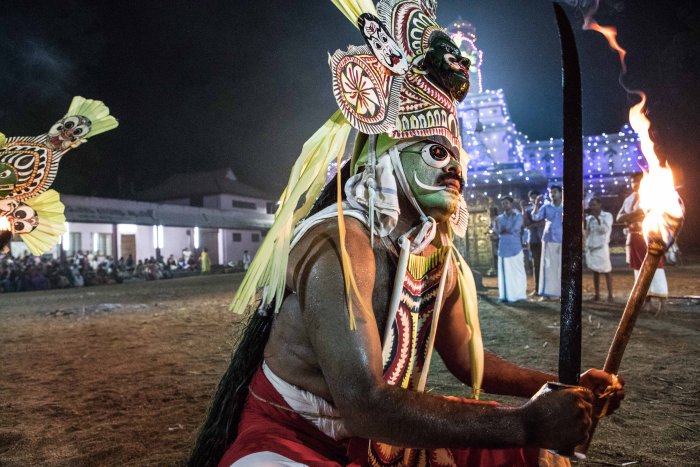 I) The Predravidian Kerala legacy "It's my dance-give it back to me." - La Danseuse (French movie, October 2016) Let alone the idea of getting hints from an inspiring ritual, rural source in most cases acts like a rejuvenating incubator of talents for 'Shastriya Natya' - the corpus of Indian classical dances [1]. Classic tradition, its model rooted in Hindu history, versus rural creativity, a disposition of the mind, expressed bodily in a "freer way", would be two terms: the two sides of a formal disengagement. Once looking into productions, rural epistemology brings more aesthetics to the light. We find any time the evidence of an argument, a mood or a gesture was picked up from rural performance, passed on to the classical repertoire; it soon has modified the scale of body language. It was the case for the canonization of Bharatanatyam (1932), led by Rukmini Devi Arundale, according to a procedure Indira Viswanathan Peterson describes entirely in the genesis of the art form, outside its rural origin [2]. It is also true for Ottam Thullal, inspired two centuries ago from Padayani vinodams. Something was borrowed, and it was deviated. Much of what creators have picked from the rural, the musical or the dance motif, the idea or the narrative once performed, has generated something different in another social context. The third aspect of the creative model we are questioning relates to what people perceive as being "new dance and music", and more precisely the idea of translating a change happening in the rhythm of societies, into body motion. Based on live experience, our close worldwide dance memory captured on movies and documentaries is still fresh, yet it gives insights on societies. In examining a choice of captures: any footage relating to body expressions from the past century, boldness in style, either rock, funk and disco caused a first shock to our senses. As an artist, from my personal experience, original punk rock and cold wave bands enthralled the people of my generation; actually, we are not sure whether these meteors were only fads or were they already engaging a more radical change concerning body representations. Soon they disappeared. What happened to "Martin Dupont [3]" and "The Sound [4]", were they not economically attractive enough? And those shooting star dance companies in their wake? Engulfed with their codes; erased in the lot, forgotten; finally hidden to the group who supported them so much, we can assert the process of transmission failed to a certain extent for us, the baby-boomers. Because their musical memory was underrated, they will stay stored on shelves as a stagnant pool of data; ignored for what they meant, at the opposite of a work of art making sense in history. For those who made it with history, the range of interest of the document is expanding with time pass; it's becoming wider than what we saw or remember being significant. The recollections we project on the spectacular event are emerging together with the artefact; moreover, another layer of comprehension is appearing. Like a superimposed discourse, some rare moments of performance bring a different significance to group behaviours, in a way one cannot detach anymore the move at the time of performance, from the social and anthropology context. Now with changing times and geography, we find in Kerala with performing arts, another aspect adding alternately to that hidden/open progression in history. Rural genres seem to be "pushing" in another direction of understanding that dramatically includes the vertical relation of performance, once it is hooked to the spiritual aspect. What we discover in the old Indian sacred dances is a constant call for the actualisation of body processes, because the sense of body awareness has always been at the centre of all concerns. 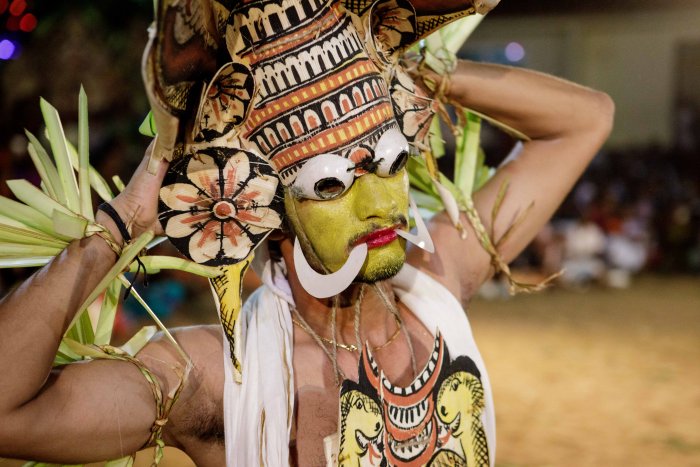 A rural genre like Padayani ought to be considered for what it was initially made for. Created to be an operative ritual (the word "operative" being fairly redundant with "ritual"), to be spiritually engaged implies a transformation between two body states, with the use of movements, gestures, steps, the dancing tools made to "change the world": this is how the power of the Mask- the formal incarnation of spirit- is perceived. The change of reality is brought through the use of trance possession (a technique) and complementary to that, the exorcism of participants, acting concurrently. Distinctiveness in the functions, applied to the art form, will convince rural performers not to consider themselves primarily as "dancers", instead, more as doers, creators. Their goal is to confront the local population with the living forces of its cosmography;-from the group point of view, ritual helps resourcing the people's belief (only one piece, Kalan Kolam, tells an epic). It helps planning with the Masks, in complete harmony, the coming agricultural year. There it will stay, as a group project, as long as it keeps the village size, or "kara" (neighbourhood), but it was never designed for theatre buildings or street-shows (although for the migrant populations living in the Gulf countries, it is important for them to reproduce the ritual on available grounds). It was not meant either to entertain the urban middle class after daily work, based on prime-time entertainment schedules (6pm to 9pm). These plans are stranger to its purpose. When listening to narratives in each Central Travancore village concerned with the cult, the first divine story villagers tell us, relates originally to the topographic location of the belief: "Once upon a time a spirit settles in. A lady with unusual behaviour makes an appearance and sets the scene for the worship in a bush location - the kawu". 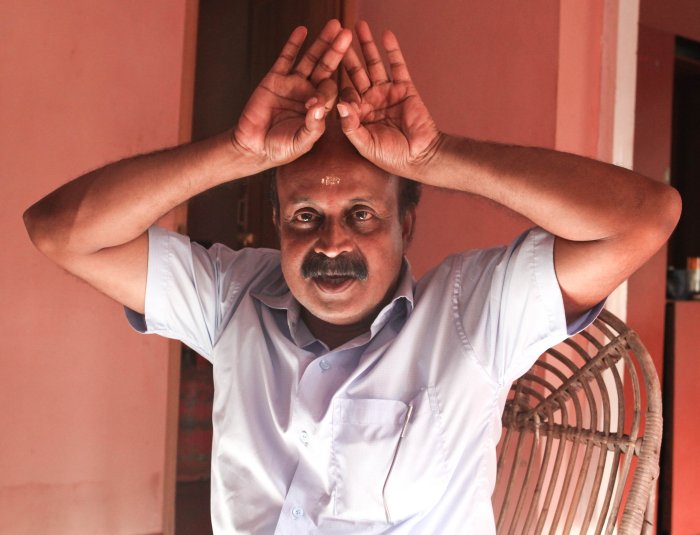 In Kerala we know, at the moment curtain is picked up for performance to start a traditional danced-theatre like Koodiyattam, we should consider the "deities" physically present on stage. It is not the case for rural genres originated from the same region. To revive the myth, the rural method of "embodying an entity" consists in the performance itself. It needs for the Mask a tremendous effort to get the mind up to the expected level of embodiment (K. Reghukumar [5]) total length of the piece depending on that aspect. Last year, Elanthoor Centre, for its Valya Padayani, proposed to its audience a much-extended version of the Mask Sundara Yakshi. Dancers were seemingly elongating movements between two postures, with an acute sense of exaggeration through the arms joints and torso, giving to the Mask a floating, unusual elastic quality and a sense of mastering weight, at the limit of falling. Rural performance needs something specific to the cult to get these changes done- that is basically the divine language into songs, in order to solve a vital issue: how do you make things "real" and immediate in the ritual progress? Being possibly the oldest of Indian legacies, what we call the Predravidian [6] heritage is designed to meet the "cosmic" spectrum of life experience. Once exploring the cult, upstream in its concepts, from outsiders view - let's say visitors, dancers from the West like me -"cosmos" (K. Reghukumar) becomes in the rural mind, the trickiest notion to grasp. Standpoint is radical, once conveyed with the symbolic figure of "Amma" - the Mother, a vast rural notion to explore. Divine dimension is expressed in a way a phenomenon bursts into human life, as soon as a force is acting between people or "creatures", and its genuine capacity to explode the initial framework (thullal- trance), whereas a classical embodiment of the character will decisively enclose dance language inside a norm. South Indian classical art forms reflect a typical way of looking at the world, or doing things; so we'd rather say the second historic legacy chronologically composes another segment of the Indian culture. What we call the classical heritage: that part of dance history influenced by a knowledge of Brahminic spiritual origin, has exerted over centuries a dominant influence on local religious beliefs, still the body representations and body work are different, starting from the first significant gesture addressed to the Divine [7]. Another aspect of the Indian danced-theatre patrimony rises in cultural productions; it adds to a much older rural legacy, though it should not be confused with it, since syncretism works well for the religious concept (transforming the old rural entities into Hindu deities), but not so well when it translates the myth into physical behaviours inherited from other indigenous traditions. On stage, a classic ambition becomes an entertainment of the highest purpose. In reviving Hindu epics, the heroic struggle for the good cause; in expressing a sense of achievement in God values, classic performances like Kathakali are meant to please the audience expectations. We find today, outstanding performers who can challenge technically and inspire many dancers in speed, precision, pop and tonicity. Performance is about theatre too. Ideas and myths are put together in a theatrical perspective. A story is told, based on sacred texts. It originates in Sanskrit in the case of Koodiyattam and it can be interpreted in Malayalam in other genres. Kerala danced-theatre conveys the myths. Meanwhile the dancing body acts as the support of the message, giving way to express tragedies, epics, according to their spatial frame, a restricted volume indeed, allotted traditionally on the temple compounds. Socially, danced-theatre genres, and classic dances focussing mainly on the feminine figure, are meant to suit exquisitely (rasa) the taste of the educated class. In terms of dynamics, a classic move is either generated from inspirations or moods, although submitted to a protocol. It consists in a representation of a specific drama situation. You could say it gets simpler in the movement reading since it matters with a mythic evocation (Gods, heroic figures, stories). When, in Kathakali, comes the time to design a plot, the master - namely the guru- starts unilaterally to elaborate a development for the story. Movements strikingly express an ongoing narrative like sign language does for the death-mutes. The guru leads the soloists along their interpretation. Dancers become his (her) interpreters. He is the one who models and tracks every action into minute details (Do this here, breath in; listen to the beat; do that precisely there, breath out; do it, and please, do not get the audience bored...). 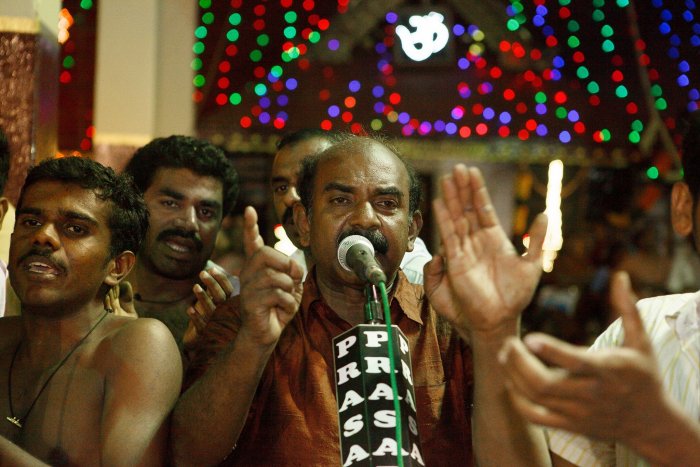 Kadammanitta Presennan Kumar P. Ashan sings in his home village (2015) Meanwhile, the local history in Travancore keeps the ritual alive in the form of verbal comments amidst rural circles. We easily find in Padayani centres a few committees of experts ready to debate about technical abilities. These men know how to elaborate a critique on aesthetics; still as transmitters they dare not express a moral judgement of any sort, like evaluating genres, giving satisfecits and objections. Even so, their competence in analysing the text of body motion through "kanakku" (the mathematics of rhythm) does highlight some differences, from the overall survey of motion sequences enacted vis à vis the musical score- like we are used to do in the West, with the cognitive aptitude that directs our common point of view on choreographic scores, when we put to analysis the juxtaposition of two elements, the visual and the musical, in time sequences. Our sense of reading motion surely tells something peculiar about our sensitivity, in the way we visualise motion through our personal motor skills. The same processes happen in Kerala considering the desi/margi, and folk/margi traditional opposition. While deciphering any statement produced in gesture language, the rhythmic pulsation will guide rural specialists. With their ability to feel what "a movement does to the mind", rural ashans easily get "what is within the motion". A number of them, well versed with martial art practice, are eager to deliver clues on how to understand their group sense of warriors, on the aspects of ethics and aesthetics. Such analytical aptitudes in Central Travancore emphasize a genuine school of sensibility that belongs to the rural education of movement. Unfortunately, most of the people who haven't got training in this aim (the science of marmas, chakras) can hardly understand what we are talking about. A notorious difference prevails for instance, between rural and classical, in relation to the controversial aspect of dealing with the process of "awakening layers of emotions" during performance, either on the side of the performer, or on the audience side. We see in Kathakali, facial gymnastics shaping the expression of the character, from "outside-in" (Margi Kathakali School) - and it stops. A fence is set in performers' expressions that helps to cease connecting the mind with the self, so - Feel angry, but don't be angry. Reversely, the Padayani Mask (called "Kolam", with a sense of identity) deals otherwise with body and senses. The rural technique works "inside-out" in a kind of effort that makes our guts "turn into sheer nerves" and modify our behaviours from within. The Mask proceeds at the place where the group has settled its belief. It works out from there, and from there it can influence the community. Over time, the worshipped spirit creates"a space of its own". Ashans call it a territory (the spatial expansion of the entity in rural tantras). Spirit is designing a territory; that means it anchors its power into that place. On rural stage, at the moment of trance, everything the group is doing becomes emotionally charged - the cult is alive, for performers and the assembly; from feet to head, all senses awakened, "spirit is fully coming to life, and in a flash, it disappears." 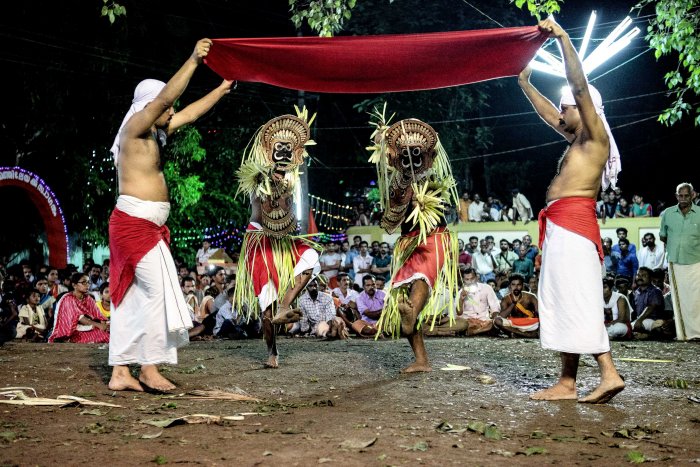 What is cleared by the intelligence in the dance construction breaks away from the sensitive gaze of the imagination. Having said that, fixing dance movement in a classic vision will cause a "side effect" for the rural eye. For a trained eye, any movement performed in the classic dance method will have the curious consequence of "encapsulating life". There is a metaphor of a "subtle freeze process" encrypted in physical action, which is a rural perception of the Indian classic approach of body motion [8]. Sensitivity operates from the point of view of specialists, with the movement design, like in a vital contradiction. The way the genius of rural culture acts, the cult, by "working in-between dimensions", differs from the classical regime of motion, where movement works "clearly between virtual limits, we can feel it" (K. Reghukumar); reason is that the rhythmic pattern of music is "abstracted from life". Classic genres establish and fix their typical designed effort- it looks like "forever" in the motor flux.The process sets a mark and a different print on people's sensitivity, other than how the old rural system would do. In case of classic dance, it is almost like "copyrighting" a vision of life. The method produces a definite text through "choreography", that can be "repeated" as in the original sequence. Then again, the Western term "choreography" could be inappropriate, and therefore is controversial in the Indian context. From the East to the West, a broad mapping of the operative dance choices shows there is a perceptive treatment of both music and dance media, constantly happening when setting movement behaviours as a public representation, on stage, in any anthropological group; one can say a cultural way of doing things. We understand dance construction carries everywhere the haunting problem of its genesis, at least in many dance forms. Setting individual movement and group action in choreography is not specific to the Indian heritage; it happens also in Western dance, be it "classical ballet," "contemporary-classic", or "post-modern". In this regard, it would be interesting to know why people in the West call classical (ballet classique) a specific motion -a particular disposition of the mind according to a specific body motion -sharing possibly some identical features with the same (adopted) English term classical, the way it translates specifically a movement, or the way it designates a collection of genres in India, as inherited from Hindu culture (Shastriya Nritya [9]). There has to be something universal about dance behaviours and peculiar about local approaches (the margi and the desi concepts)-a common way of treating motion in a classic way that may be too schematic and conventional for the rural aesthetic taste. Artists treat the dance medium guided by the logic they were educated to use the music material, shared with dance movements, to the construction of a piece (be it voice, sound, percussion, the handling of various instruments). The societal frame-what it assumes in terms of "model" for the students- is important. In learning dance, the student artists depend mostly on the mainstream education (academies, universities, kalaris, families) to fulfil their artistic needs. A break in the teaching systems, outside regular academies, could signal a significant change in transmission, and the outcome of other new models. It happened at the end of the Modern dance era in the United States with John Cage's musical approach. The composer launched a conceptual revolution in the Fifties, in collaboration with choreographer Cunningham; together they initiated a new era of dancing in USA, on university grounds. The musical bias they agreed on connects originally the acoustic material with movement, only on the time plan. Like Merce Cunningham says, "Dance and music share the same time and its division." It would act like a designed patchwork of various time-sized pieces, unrolled to our senses. Successively, musical sections are found fitting "exactly" the general format of the dance piece. Sometimes music coincides with movements by chance - and this is fine. Yet the coincidence of music and movement become purely accidental. Other than Cage's musical ideas, most times dancers will adjust to the rhythm of music implemented by the music composer, in any composing style, for the majority of Western classic productions. The basic model (splitting dance from the sound score, yet working together on a selected pulse) is a cultural print that prevailed for centuries, as long as dance held the societal function of entertaining, either the"low-class" people, or the élite, and when music was following the notation system. We may consider a dance piece fits in the musical score, in Europe in the classical format, approximately from Jean-Baptiste Lully to Igor Stravinsky. Nowadays, it keeps on being this recognizable in-printed cultural habit, when the same composing method prevails, based on the "equal musical time division"; -in fact many dance styles (from ballet, jazz to contemporary) systematically mould in the Western "classical" tradition. We see that the European culture has imposed, through its insistent cultural and economic influence, one way or another, a normative system of working music and movement with the help of written musical partitions. It happened and the system was pursued under the influence of royal court dances and the figure of the Dance Master. Such a typical approach has designed a model for many dance styles, and made it an ethnocentric model- a prestigious one- to spread worldly. According to that structure, movements fit in essence a geometrical sense of time. It's all clear-cut and strong. Technically it allows disruptive body actions and large group actions that can move in perfect synchronisation. To refer to an equal time division, always relying on music construction, helps unifying the sense of reading movement. But visually, we can say, the system is "limited". You find soon how easy it is to "classicise" any rural motif; you just need to change the mood, and keep a steady meter in the mind, like a metronomic print in projection. Wishing to be perfect and blinding some physical limitations to the audience, will leave people in the audience deeply unsatisfied, because in that system, there's hardly any room for any individual space design inside the group. Rural transmitters in Kerala say, "It's automatic and predictable, you can guess right away where the whole thing is going -it may create a certain type of "beauty", but it cannot change the world". In the rural case, with a different mind, instead of putting together a piece that is "made with music and dance", which comes merely to piling up audio sequences and movements in a "predicted" manner, rural performers developed another capacity of "unfolding the life process", one can say on the spot. Their performance consists in a series of grids, with a sense of duration, according to the use of specific musical rhythms they are generating. The rhythmic material (vocal and instrumental) fits with every performer in their rhythmic personal template. Sound as a vibration works at the root of movement or gesture. We can switch instantly from one form to another form, and "from one realm to another realm", instead of "flattening reality" artificially. That much freedom is cleared for the rural. The Mask is "creating reality- its reality" with a sense of diversity, and it goes on doing so, incorporating the complexity of relations between partners, including the audience perception. Spirit, the leading force in the dance, is meant to drive the people's mind - spirit is a dance force that federates vision, and if dance "wants to tell a (mythic) story" it fails for structural reasons. No one knows what is going to happen on a rural stage; one thing is sure, what happens is truly unprecedented. 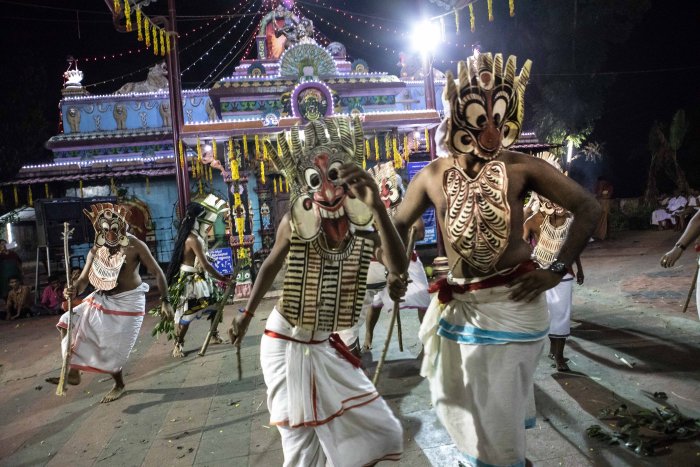 Nevertheless, "predicting movement" in ordinary choreographies, by fixing moves in an abstracted time-space unit, may hardly reach the artistic height of some improvised "lucky moves" hitting their target every time with a sense of à propos- dancers know that from experience. Wishing to get dance "as fresh as an improvisation flavour" has been a steady concern for artists like Simone Forti and Trisha Brown, both on the American Post-modern scene, in the Sixties. The matter is getting crucial nowadays for contemporary dancers; mastering improvisation becomes the core in a number of teaching programs in European dance studies. Reciprocally, Indian rural dancers trained to perform that instant peculiar mood, are standing far away with their technique, from dance "improvisation" in its American context (Simone Forti, Judith Dunn, Lisa Nelson). We will give evidence that "freedom applied to motion" translates very well with a different focus in Indian rural customs when it comes to building up the performing body state, so vital in every culture. 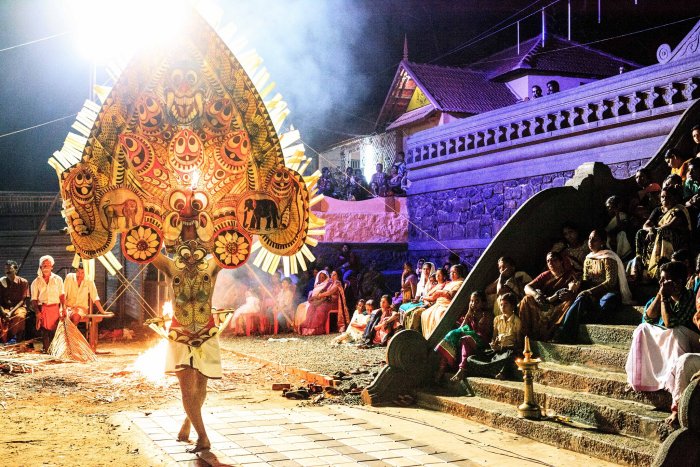 "Rural versus Classic" in India would denote a dichotomy in the treatment of body motion, resulting from a different appreciation on dance and music organization. To get evidence how rural procedures are adapted to the "perception of a spiritual entity" boils down to analyse the role of sound and rhythm. Now facing rural heritage, rhythm in Padayani owns its proper significance by adapting the pulse to each individual particularity. In addition, rural rhythms refer to a specific entity: the invoked spirit; what we are looking for is the key to that knowledge. The issue might be of a cognitive nature and it became probably a societal problem later, partly because of a formal ignorance and misunderstanding. When one talks about "tradition" and refers inappropriately to "folk art in India", they tend to forget about the relevance of a few old sacred rural arts involved with a specific body work - the covenant with the "spiritual" force -although at this point, notions like past or future are obsolete. The "dancing cult" is deeply built in body memory; for artists, paying no due attention to it could become "visible"; some unawareness could spill aesthetically in front of the audience. Rural genres are assigned over time as folk arts in the doxa. "Folk" is "superficial"; "designed" for the "common people" (Michel Leiris [10]) or with a sense of anachronism, it targets an ancient egalitarian society. That doesn't make sense if we refer to a "common" group of techniques that turn out to be highly complex.There is a chance that something was historically understated or hidden in the approach of rural legacy. In the meantime, folk arts have been assigned to maintain a restricted interpretation of societal traditions."Folk" popularity is becoming, in a paradox, notably more prominent as a "flag status" over the recent past with strong social connotations. Economy factors possibly unsettled the perennial agricultural concerns, thus inhibited the rural dance process, by transforming it into big mass events, just for the sake of it. Now is the time when the small State in the subcontinent tilts into a different economy. While the local tourism industry (Kerala owns one of the world's biggest scores) is adapted to live electrical performances, the legacy of rural art forms gets vulnerable to a genre mutation. We knew the change was deeply launched within the society, before it got a chance to be formulated today -"folk" is a word with a colonial story in India, and sensible effects, present now in the dance production. 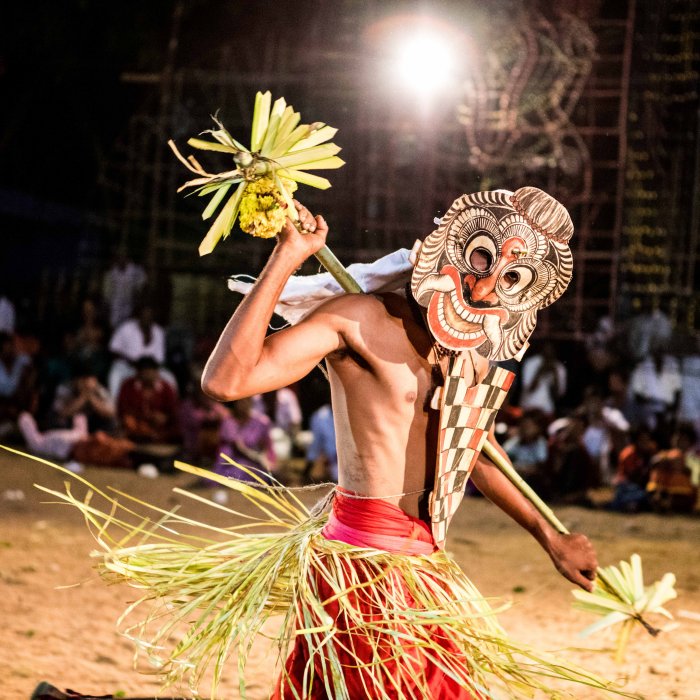 How then should we understand the statements of festival programmers, concerned with the artistic impact of "folk arts" in the entertainment field? They recently suggested (Chennai Chronicle, 31 August 2015 - « Folk gets larger canvas ») some change must come from rural arts to help intertwine the myth to contemporary reality, V. R. Devika asserting, "Folk art forms (including Padayani) need to come to the mainstream stage". Does it mean that rural sacred art forms (referred to as "folk arts") should adapt their practices, and change them so they can fit a different society? Devika adding, "There is a danger of these forms being thought of as being ritualistic: practices that cannot be sustained. Folk art will get replaced if we don't give it a larger canvas." The accurate rural vision acquired with practice is evacuated with the back of the hand as soon as contemporary artists decide to assign rural arts at the service of a different genre, especially when they propose (for any good reason) to reform the sacred aspect of it- it proves to be volatile, perhaps because the core of the technique was historically unrecorded, so it is impossible to bring a theory of rural sacred Masks forward. Propensity in the diversion puts out to question the capacity of tradition holders to preserve their cultural message [11].  Prof. Kadammanitta Vasudevan Pillai sings in his home village. From the point of view of trading artefacts in terms of legal law, our query becomes, 'Can you change a ritual without changing the message?' One questions reasonably first-who owns the authorship of a piece [12]? Is it the original group ("kara" - locality or village) who embodies the communal legacy, or else in case of "contemporary dance" outside rural locations, the modern author who claims its rights on a new creation? On another level, balance of the question remains - who writes the piece? The choreographer or the interpreter, the latter inclined to ask for a co-signature of the production; so much energy is taken from "himself"/ "herself" to perform the sacred. The issue becomes a matter of socio-economic values. In logic, the intellectual property code allows the author to claim authorship and earn royalties. Authorship in Europe is a long fight for the artist recognition-the condition for money entitlement. Interestingly, the idioms artist choreographer and choreography in their modern (Western) acceptation of recent origin (1912) do not have the same meaning as the Language of the Mother taught by a guru in Kerala. We observe that the Western economic model, as it is adapted to performing arts, is not fitting the old Indian mind. Especially in the case of the Sacrifice to the Mother, the worshipper is fully offering his time and efforts to the cult. 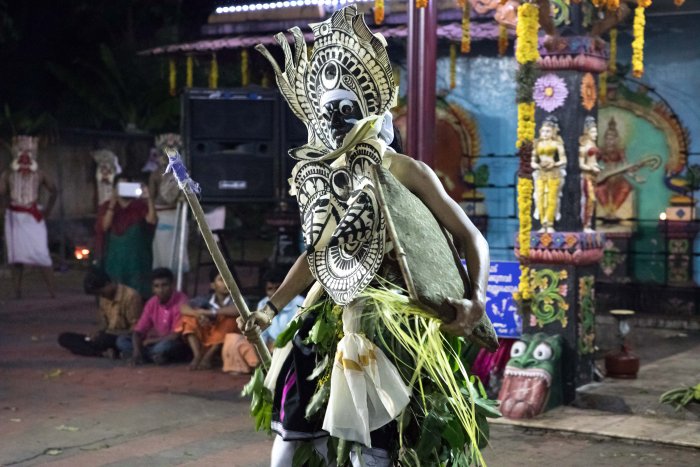 There are two aspects in the authorship issue. One is the exploitation of a "dance piece" on the economy market; the second element questions the relevance of the ideas of "duplication", "reproduction" or "interpretation" for any dance piece performed on a public stage. The possibility for a "dance creation" to exist on a score sheet - the material proof of its existence - implies the invention of a notation vocabulary. In the 19th century, in France, only authors of ballet booklets (who used to summarise the dance action by plain description) and music composers could be recognized as authors. Later on, the labanotation system, dated from 20th century, got the preference. It was used among other devices to track and write choreography. As we know labanotation, although strongly supported by public institutions, is not working for many post-modern styles, so today a video capture will do as well. These proofs help to determine the authorship signature and its seniority. An arsenal of jurisdictions defines the author's rights as well as the interpreter's, towards a much-expected co-authorship. Further negotiations pave the legal process for selling and reproducing a dance piece on the market. 'A "same" piece?' they say, qualification of "same" being a quite debatable subject. If there can't be "two Mona Lisa alike" in painting, how should we consider the dance medium, the duplication and marketing of dance pieces, living their public life far away in time and location from their initial designer? What about the loss in the character from the initial creation? Behind the quarrel of rights, the vision of dance is deeply questioned, as an economy product, and consequently depending on the case, the possibility of its transmission doesn't have the same anthropological importance. 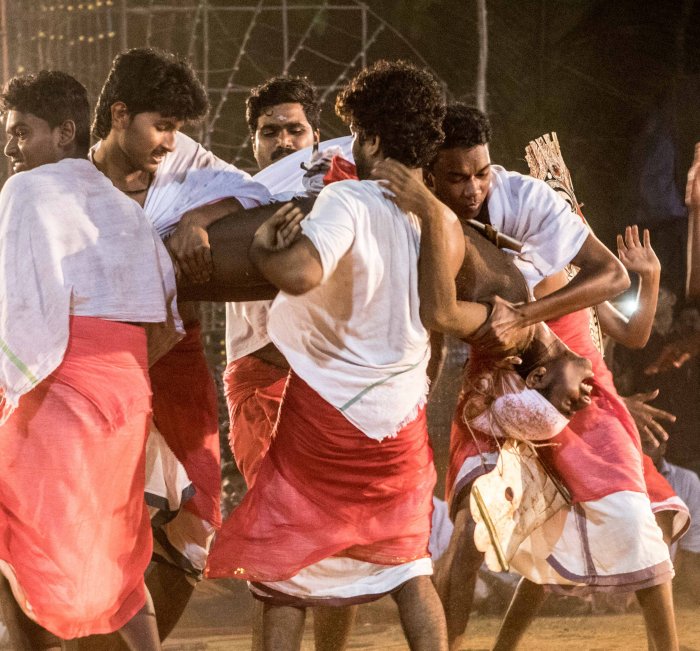 Copyright in India does not apply to, nor protects, rural productions. Should anyone be tempted to use the "rural dance material" according to its will, there is no body of authority existing in terms of dance legacy to claim a cultural right, for the sake of protecting a given heritage. This aspect introduces the notion of moral property to the debate, and it is not making things easy. Sponsor families are yearly financing Padayani festival productions. While choosing the content of programs, their informed choice tends to give an orientation to the legacy. It is in truth the ashan who keeps up the future of the heritage, with an extremely codified transmission procedure, although his practice is only recognized by custom. No one can decide how "to protect" a sacred art form, when many manifest a concern with the destiny of the genre; what it could become outside a museum sideline perspective. We need to apprehend the rural genre otherwise, more like an "artistic or a sacred content inside a social content" that can exist beyond the simple idea of a repertoire, however a protected structure, including every designing unit and each scientific knowledge available, is not yet formulated. A complete repertory of body techniques could help understanding how the Predravidian culture works the rural body, and hence begin to define Padayani inside a modern society. Moreover, should a "contemporary artist" assume its interpretation on any selected Indian tradition as a valuable source of inspiration, its mental attitude, once at the service of a modern creation, may all at once underestimate the collective work at the level of the "unseen" and the "non-heard", like in the universe of rural art forms from Central Travancore - and this, in our research, is another genuine aspect of Indian legacy we need to explore.  Footnotes 1. Performing artists were attracted to South India, not so much as an ethnographic field, but for many the cultural treasure of dance and danced-theatre has inspired the coming avant-garde: Jerzy Grotowsky, Richard Schechner, Ruth Saint-Denis, Min Tanaka... 2. INDIRA VISWANATHAN PETERSON, The evolution of the Kuravanci dance drama: Negotiating the folk and the classical in the Bharata Natyam canon, New Delhi, Sage publications, 1998, 34 p. 3. Just because (Facteurs d'ambiance - AA 002, 1984). 4. From the Lion's mouth, 1981 5. Taught in tutorials. 6. The population of Padayani devotees in Kadammanitta is composed of a number of communities, or castes, working notably together at the time of festivities: Nayar (60%), Kuravan (10%), Kollan (10%), Achari (10%), Ezhavan 7%, Ganakan (2%), Veluthadam 1%. Source REGHUKUMAR Ashan, Gothra Kala Kalari, Kadammanitta. This community ratio should apply with some variations to all Padayani centres. The denomination "Pre-dravidian" is currently used in the teachings of South style centres, where the suffix "pre" makes sense when you need to incorporate the "Dravidian" theatrical section, Ourali Padayani, into the rite, which becomes historically a part of the genre, although the communal theatre of divination, held by the Kuravan community, stays distinct from the much older "danced section". 7. Padayani Rural Tantras "The Aesthetics And Embodiment Of Beliefs And Identity", 19th May 2013, in Aswadanam; 8. The perception is sometimes justified in Bharatanatyam by dance technique with the evocation of traditional postures picked up in their stunning succession from a series of carved temple stones. 9. Shastriya Nritya does not include Koodiyattam, although close to Kathakali. 10. Zébrage, 1992, Folio Essais, p 147. 11. The colonial introduction of the notion of "folklore" in India by England could have devastating effects, despite the fact that the agricultural and rural fabric - the background of Padayani - was still almost intact in situ, thirty years ago, for the ritual practices of the federating Culture of the Pamba River. Reality looks different in Mali, under contemporary other skies. The fate of "folklore" on the African soil, introduced by France into its colonized territories, has given rise to disappointments; let us remind the myth of the Dogons, deliberately maintained by local "performers" for researchers looking for ethnography, and tourists looking for exoticism (Anne Doquet). 12. The copyright protection is governed in India by the Copyright Act of 1957, which has undergone substantial changes since 1983, the last was made in 1998; very influenced by British law, the copyright regime however presents specificities. In a country of « civil law » like France, it is the Article L111-1 paragraph 1 of the ICC, which states that "the author of a work of the spirit may enjoy on this work, the mere fact of its creation, an intangible property right, exclusive and enforceable, against all". Thus, protection of copyright is acquired simply because of the creation of the work and without the need for the author to complete formalities. The intellectual work is original and manifested regardless of form, condition, gender or merit. To be protected the work must have reached a certain degree of formalization making materially perceptible (ideas are not copyrightable) but it must be original, that is to say, it must bear the stamp of creativity and reflect the personality of the author. Source: "La cession de droits d'auteur d'œuvres chorégraphiques", CND, département Sources professionnelles, September 2015. In a country of "common law" like United States, the doctrine "work-for-hire", that is to say "work order" or "paid work", is an exception to the article 17 USC 101 (2000), which provides that the person who created the work is the author and therefore benefits from the copyright. If a (dance) work is created by an employee as part of his work, the employer will be considered the author of the work. There is a presumption in favour of the employer. This doctrine has as its foundation the idea that the employer should be rewarded for taking the initiative and the financial risk that led to the creation of the work that benefit as the public. Source, Chloe Bordon dans MBDE, Droit des biens et des propriétés intellectuelles, June 25th, 2012. 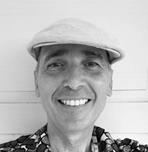 Marc-Paul Lambert, a member of Gothra Kala Kalari since April 1998, received Padayani initiation from his Padayani guru, Kadammanitta Reghukumar. A graduate from Bennington College USA in dance, and owner of a PHd in Ethnoscenology from Paris Vincennes Saint-Denis University, he works as a free-lance multimedia artist. Marc-Paul Lambert in history is the first dancer from the West to be enrolled in an Indian rural sacred dance team. June 5, 2017 - Thiruvananthapuram Ethnoscenology Laboratory, Paris Vincennes Saint-Denis University Contact: sundara2004@yahoo.com Post your comments Please provide your name and email id when you use the Anonymous profile in the blog to post a comment. All appropriate comments posted with name & email id in the blog will also be featured in the site. |